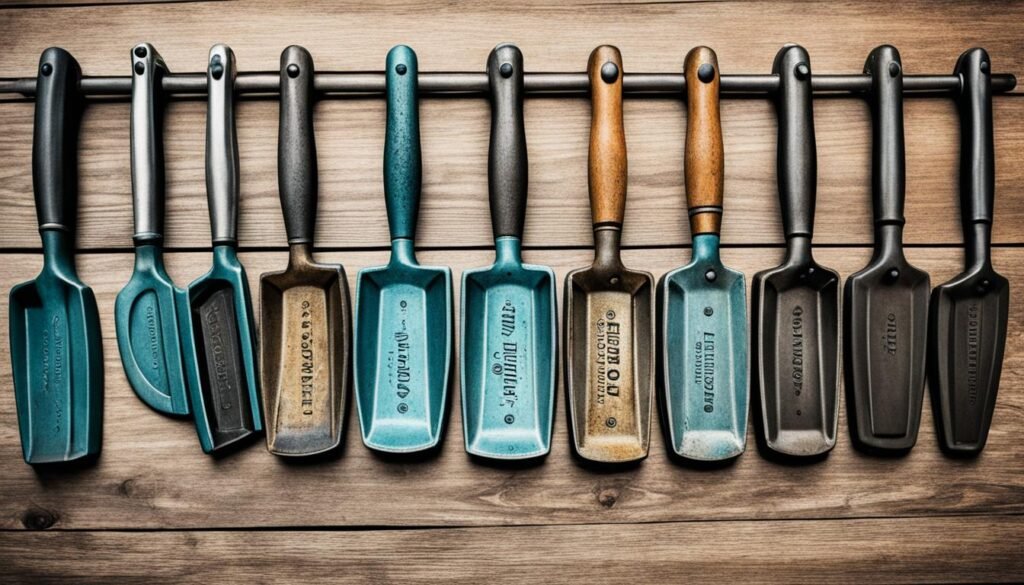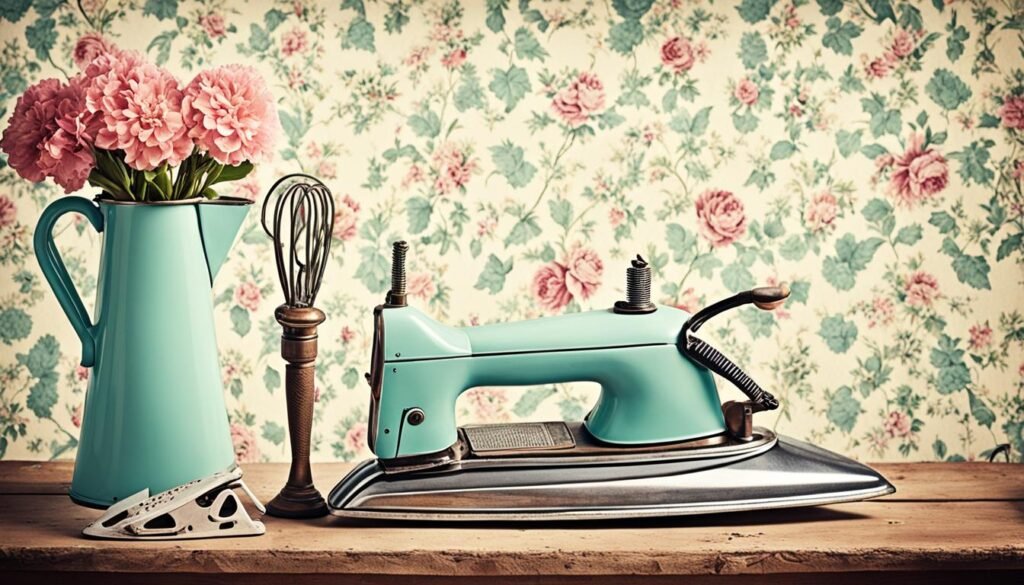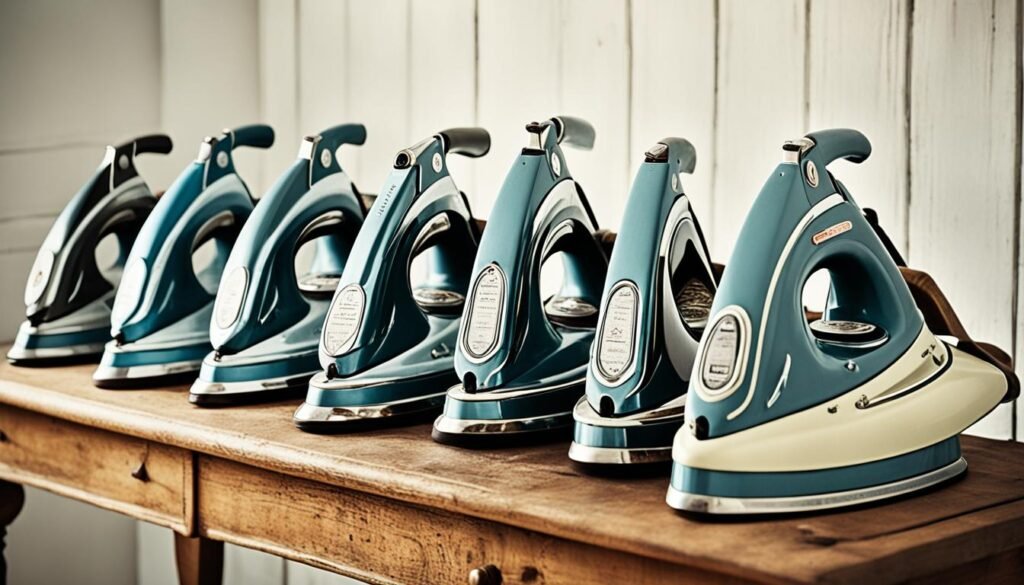Sad irons, or flat irons, are antique household irons made of solid cast iron. These antique irons were popular in Europe and America from the 17th to late 19th centuries. They continued to be used in rural areas into the early 1900s.
These heavy irons typically weighed 5 to 9 pounds. They were heated in front of fires or on stoves before use. The irons were then used to press and smooth fabrics.
Women needed to master the use of sad irons. This included heating them and controlling their temperature. It was a crucial skill for housekeeping in those times.
Table of Contents
ToggleKey Takeaways
- Sad irons, also known as flat irons, are a type of antique household iron made of solid cast iron.
- These irons were widely used in Europe and America from the 17th to late 19th centuries, and into the early 20th century in rural areas.
- Sad irons typically weighed 5 to 9 pounds and were heated on stoves or in front of fires before being used to press and smooth fabrics.
- Mastering the use of sad irons, including heating and temperature regulation, was an important skill for women in the past.
- Sad irons remained popular until the introduction of electric irons in the 1930s, but are still sought after by antique collectors today.
What is a Sad Iron?
Sad irons are antique household irons made from solid cast iron. They got their name from the Old English word “solid.” These heavy irons weighed 5 to 9 pounds and had a triangular shape.
Sad irons had handles and were great for pressing fabric flat. Their weight made them effective for smoothing out wrinkles in clothes.
Origins and Definitions
Heated metal tools for ironing have been around for thousands of years. Ancient China had the earliest known examples. Early tools were made of stone, glass, or wood.
In Wales and England, these tools were called “slickstones” or “slickers.” Blacksmiths started making flat irons in the late Middle Ages.
Physical Characteristics
Sad irons were the largest and heaviest flat irons. Their weight helped press fabric flat during ironing. They often rested on metal trivets made of cast iron, brass, or steel.
“Mary Florence Potts, at 19 years old, invented and patented the wooden-handled sad iron in 1870.”
Using sad irons required constant care to prevent rust. Cleaning, sandpapering, and polishing were necessary. Ironing was a hot, difficult, and sometimes dangerous task.
Most homes had at least two sad irons. This ensured they could keep ironing without interruption.
The Sad Iron’s Journey Through History
The sad iron has a rich history dating back to ancient China. It was used for smoothing fabrics as early as the 6th century AD. This essential tool spread to Europe and America, becoming common in homes from the 17th century onwards.
Ancient Chinese Beginnings
Ancient China saw the earliest precursors to the modern sad iron. Solid metal irons were used for pressing fabrics in the 6th century AD. These tools, heated over charcoal or wood fires, paved the way for future innovations.
Widespread Use in Europe and America
Sad irons became a household staple in Europe by the 17th century. They then made their way to the American colonies, remaining popular through the late 1800s. In rural America, sad irons were used into the early 1900s due to limited electricity.
| Region | Timeframe | Sad Iron Use |
|---|---|---|
| Ancient China | 6th century AD | Solid metal irons used for fabric pressing |
| Europe | 17th century | Sad irons became a household staple |
| American Colonies | 17th century | Sad irons in common use |
| Rural United States | Early 1900s | Sad irons persisted due to lack of electricity |
The sad iron’s evolution showcases human ingenuity and its lasting impact on daily life. Its journey from ancient China to widespread use demonstrates its crucial role in households worldwide. This simple tool has left an indelible mark on history.
Heating and Using a Sad Iron
Before electric irons, households used the trusty sad iron for ironing. These heavy, solid-iron tools needed heating in a fire or on a stove. Users would heat the iron until it absorbed enough thermal energy for pressing fabrics.
The heating process could take time due to the dense metal. Some homes rotated between multiple irons to iron continuously. This method allowed for uninterrupted work as irons cooled and reheated.
Regulating the sad iron’s temperature was challenging. There were no built-in controls, making it difficult to maintain the right heat level.
The Heating Process
Sad iron users carefully monitored the heating process. They often used a damp cloth to check the iron’s heat level. Getting the right temperature was crucial to avoid scorching clothes.
Heating methods changed over time. Early users relied on open fires. Later, kerosene stoves and gas ranges became popular for heating irons.
Temperature Regulation Challenges
Maintaining ideal heat for ironing techniques was tricky with historic ironing processes. Experienced users developed ways to assess their irons’ temperature regulation. They often tested the heat on scrap fabric before ironing clothes.
| Year | Heating Technology Advancement |
|---|---|
| 1882 | First kerosene stove developed by “The Old Swede” |
| 1888 | Taylor & Boggis Foundry patents single-burner “Lamp Stove” |
| 1890 | Cleveland Foundry Company produces 1, 2, and 3 burner “Lamp Stoves” |
| 1893 | Cleveland Foundry expands Lamp Stove line, adds oil and gas stoves |
| 1894 | Cleveland Foundry introduces “Blue Flame” wickless oil ranges |
Heating technology advancements shaped the history of using sad irons and heating sad irons. These changes led to more efficient and convenient ironing methods over time.
Preventing Fabric Damage with Sad Irons
Using a hot sad iron on fabrics required great care. Users would test the iron’s temperature on scrap fabric before using. Constant motion prevented scorching in one spot.
Many relied on a pressing cloth between the iron and garment. This thin fabric barrier protected materials from direct contact. It helped prevent damage and ensured a smooth finish.
| Cleaning Product | Purpose |
|---|---|
| WENOL German-made cleaning paste | For cleaning and polishing irons |
| FLITZ Metal Polish | For polishing irons |
| WD-40 Spray lubricant | For lubricating irons |
| SNO-BOL toilet bowl cleaner | For cleaning irons |
| Turpentine & Boiled Linseed Oil mix | For cleaning and conditioning irons |
Proper care of sad irons was crucial for effective functioning. Best practices for heating and temperature regulation were important. Using protective accessories ensured a smooth ironing experience without damaging fabrics.
Ironing Techniques and Workflows
Sad irons demanded unique skills and methods. Their heavy weight meant less pressure was needed. Users had to keep the iron moving to avoid fabric damage.
The iron’s weight did most of the work. A smooth, constant motion was key. This approach prevented overheating and protected the fabric.
Continuous Motion and Pressure
Effective sad iron use involved sweeping across the fabric. Too much pressure could scorch or burn the material. Users gently guided the iron, letting its weight work.
A smooth, unbroken glide was essential. This technique produced crisp, wrinkle-free results. It required practice and a light touch.
Multiple Iron Rotation
Households often had several sad irons. This allowed rotation between heated and cooling irons. Users swapped irons to maintain consistent temperature throughout ironing.
While one iron was in use, others heated or cooled. This workflow ensured efficient ironing. It kept the process moving without interruption.
| Historic Ironing Process | Modern Ironing Techniques |
|---|---|
| Sad irons heated on the stove or over a fire | Electric or steam irons with temperature control |
| Continuous, gliding motion to avoid fabric damage | Combination of steam and dry ironing for optimal results |
| Rotating between multiple heated irons | Single iron with rapid heating and cooling |
Sad irons required careful handling and smart workflows. These methods produced the best results. Today’s ironing innovations have made the task much simpler.
Sad Iron Variations and Improvements
Innovators sought to improve the essential household sad iron. They developed irons with removable wooden handles to prevent hand burns. These changes made ironing more manageable for users.
Removable Wooden Handles
Standard sad irons quickly became too hot to touch. Removable wooden handles solved this problem. Users could detach the handle to grasp the iron safely.
This simple change improved the ironing experience. It made the sad iron more comfortable for long periods of use.
Asbestos and Charcoal Irons
Other variations emerged to manage heat issues. Asbestos-lined irons insulated the handle from heat transfer. Charcoal-heated “box” irons allowed for more localized heating.
These historic tools represented important steps in laundry tech evolution. As sad irons improved, they became more efficient and user-friendly. This eased the burden of an essential household chore.
| Sad Iron Variation | Description | Approximate Price* |
|---|---|---|
| Revolving Alcohol Fuel Iron | An iron with a built-in alcohol fuel chamber for heating | $1,295.00 |
| Jewel Natural Gas Iron | An iron that used natural gas as a heating source | $1,895.00 |
| Hood Patent Soapstone Polishing Iron | An iron with a soapstone surface for polishing fabrics | $275.00 |
*Prices reflect recent sale results and current market values for antique sad iron variations.

The Transition to Electric Irons
The iron has evolved significantly over time. Electric models replaced traditional sad irons, marking a technological leap. The first electric iron debuted in 1882 but faced challenges like lack of temperature control.
The 1926 electric steam iron made ironing safer and more user-friendly. However, rural areas were slow to adopt this technology due to limited electrification.
By the early 20th century, electric irons gained popularity. In 1932, Switzerland had an impressive 17.5% household iron penetration rate. The 1905 Hotpoint iron, designed by Earl H. Richardson, achieved commercial success.
Electric irons continued to improve over time. By 1941, 79% of American households owned an electric iron. It was the second most common appliance after radios.
Innovations like thermostatic controls (1935) and aluminum sole plates (1938) enhanced the ironing experience. These improvements tackled issues such as rusting and temperature regulation.
Electric irons transformed a once-arduous task. They became essential household tools, showcasing the power of technological progress. Today, these modern appliances offer convenience and safety for everyday use.
| Year | Milestone |
|---|---|
| 1882 | First electric iron introduced |
| 1905 | Hotpoint iron designed by Earl H. Richardson, achieving commercial success |
| 1926 | Electric steam iron invented, making ironing safer and more user-friendly |
| 1932 | Switzerland had an iron penetration rate of 17.5% in households |
| 1935 | First electric irons with thermostatic controls introduced |
| 1938 | Aluminum sole plate introduced, solving the issue of rusting |
| 1941 | 79% of American households owned an electric iron |
Sad Iron’s Impact on Women’s Lives
Sad irons were crucial domestic tools that shaped women’s lives. Mastering these heavy irons was essential for women and young girls. They had to learn heating, regulating, and using them for ironing clothes.
These irons posed significant challenges and dangers to women. The intense heat needed for ironing could cause painful burns and injuries. This added to the physical strain of this time-consuming chore.
Women had to endure these hardships as part of their domestic duties. The use of sad irons underscored the difficulties they faced in their daily household tasks.
The Potts iron, invented in the late 19th century, improved the ironing experience. It featured a detachable wooden handle and interchangeable iron bases. This invention made ironing more manageable for women across North America and Europe.
Sad irons reflect the persistent gender roles of the past. Women bore the burden of domestic labor, including the arduous task of ironing. This highlights the challenges they faced in their daily lives.
| Year | Potts Iron Price | Features |
|---|---|---|
| 1894 | $0.90 | Wooden handle, detachable iron bases |
| 1896 | $0.70 | Wooden handle, detachable iron bases |
| 1908 | $0.78 | Wooden handle, detachable iron bases |

Sad irons offer a unique window into women’s past struggles. They reveal gender roles, domestic responsibilities, and the fight for equality. These tools help us understand the hardships that shaped women’s lives throughout history.
Collecting and Appreciating Antique Sad Irons
Antique sad irons have become prized collectibles for many people. These heavy, cast-iron tools were once essential for pressing clothes. Now, they hold a special place in collectors’ hearts.
Collecting vintage laundry tools like sad irons connects people with the past. It offers insights into the challenges our ancestors faced in maintaining their households.
The term “sad” in sad irons means “solid” or “heavy” in old English. During the Victorian era, these irons underwent significant design changes. Improvements included better handles and hollowed-out cores for reduced weight.
The materials used in sad irons reveal manufacturing techniques and economic conditions. Cast iron and brass plating were common materials used in their production.
Today, collectors seek antique irons that showcase the evolution of these historical household items. Early examples feature triangular or trapezoidal bodies with wooden handles. Many bear unique markings, like logos or patent numbers.
| Manufacturer | Years of Operation | Specialty |
|---|---|---|
| W. H. Howell Company | 1867 to 1954 | Sad irons, trivets, and fluters |
| Wapak Hollow Ware Company | 1903 to 1926 | Sad irons, sad iron stands, and various iron hollowware |
Owning antique irons helps people appreciate the hard work of our ancestors. It fosters a sense of nostalgia and connection to simpler times. Collecting sad irons has become a rewarding hobby for many history enthusiasts.
Conclusion
Sad irons offer a glimpse into women’s daily lives in the past. These heavy, cast-iron tools were crucial for laundry and ironing. From ancient China to Europe and America, sad irons played a vital role.
Modern electric irons have made wrinkle removal much easier. Exploring sad iron history helps us appreciate today’s conveniences. Collecting these antique irons connects us to our ancestors’ hardships and gender roles.
The Midwest Sad Irons Collectors Club keeps the legacy of these historical appliances alive. They remind us of past laundry practices and women’s history. Preserving these relics honors the ingenuity of those before us.
FAQ
What is a sad iron?
A sad iron is an antique household iron made from solid cast iron. It’s also called a flat iron. The word “sad” means “solid” in Old English. These irons were triangular or pointed, with a handle, weighing 5 to 9 pounds.
When were sad irons used?
Sad irons were common in Europe and America from the 17th century to the late 1800s. They were still used in rural areas during the early 1900s.
How were sad irons heated and used?
Users heated sad irons in a fire or on a stove until hot enough. Controlling the temperature was tricky, as there was no built-in mechanism. People relied on experience to gauge the heat level.
They often tested the iron’s temperature with a damp cloth. This helped prevent damage to fabrics.
How did people prevent fabric damage when using sad irons?
Users tested the iron’s heat on scrap fabric or paper before ironing clothes. Many used a pressing cloth between the iron and garment for protection. This thin fabric acted as a barrier against the hot iron.
What techniques were used with sad irons?
Using a sad iron required specific techniques. The iron’s weight did most of the work, so less pressure was needed. Continuous, gliding motions prevented overheating and burning fabric.
Many households had multiple sad irons. This allowed for rotating between heated and cooling irons, making the process more efficient.
What improvements were made to sad irons over time?
Removable wooden handles were added to prevent hand burns. Some irons had asbestos lining to insulate the handle. Charcoal-heated “box” irons allowed for more localized heating.
How did the transition to electric irons impact the use of sad irons?
The first electric iron appeared in 1882, offering a safer alternative. Early models lacked temperature control and required disconnecting home lighting. The electric steam iron, invented in 1926, made ironing much safer and user-friendly.
Electric irons took time to reach rural areas due to slow electrification. This delayed their widespread adoption in some regions.
How did sad irons impact the lives of women in the past?
Sad irons greatly affected women’s lives. Mastering these heavy irons was an essential domestic skill. Women and girls often suffered painful burns while ironing clothes.
The challenges of using sad irons highlight the difficulties women faced in their daily chores. It shows the impact these tasks had on their lives.
Why do people collect and appreciate antique sad irons today?
Antique sad irons help people connect with the past and understand household history. These heavy, cast-iron tools have become sought-after collectibles. Owning vintage sad irons deepens appreciation for our ancestors’ hard work, especially women’s household duties.
Collecting these antique tools fosters nostalgia for simpler times. It reminds us of the labor-intensive practices of the past.

